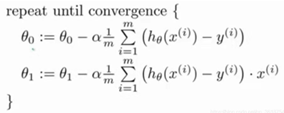实验二、三:线性回归、逻辑回归
实验内容:掌握线性回归和逻辑回归的方法
实验过程:
1.实验思想:
1.1线性回归: 监督学习算法
1.1.1单变量线性回归:
只含有一个特征/输入变量,因此这样的问题叫作单变量线性回归问题,表达方式为:![]() 。代价函数定义(误差平方和代价函数):
。代价函数定义(误差平方和代价函数): ![]() ,通过计算使代价函数最小,从而确定系数即可,采用梯度下降的方法来实现,具体的算法如下:
,通过计算使代价函数最小,从而确定系数即可,采用梯度下降的方法来实现,具体的算法如下:

注意有可能出现假最优值的点。
1.1.2多变量线性回归:
多变量线性回归主要是多了特征/输入变量,下面给出梯度下降算法的公式:
进行归一化处理
2.1逻辑回归
Logistic Regression 为回归,但其实际上是分类模型,并常用于二分类
2. 源代码
2.1.1
import numpy as np
import matplotlib.pyplot as plt
a = np.loadtxt('./ex1data1.txt')
m=a.shape[0]
print(m)
print(type(a))
x=a[:,0]
y=a[:,1]
plt.scatter(x,y,marker='*',color='r',s=20)
theta0=0
theta1=0
iterations = 1500
alpha = 0.01
def gradientdescent(x,y,theta0,theta1,iterations,alpha):
J_h=np.zeros( (iterations,1) )
for i in range(0,iterations):
y_hat=theta0+theta1*x
temp0=theta0-alpha*((1/m)*sum(y_hat-y))
temp1=theta1-alpha*(1/m)*sum((y_hat-y)*x)
theta0=temp0
theta1=temp1
y_hat2=theta0+theta1*x
aa=sum((y_hat2-y)**2)
J=aa*(1/(2*m))
J_h[i,:]=J
return theta0,theta1,J_h
(theta0,theta1,J_h) = gradientdescent(x,y,theta0,theta1,iterations,alpha)
print(theta1)
print(theta0)
plt.plot(x,theta0+theta1*x)
plt.title("fittingcurve")
plt.show()
x2=np.arange(iterations)
plt.plot(x2,J_h)
plt.title("costfunction")
plt.show()2.1.2
import numpy as np
import pandas as pd
import matplotlib
import matplotlib.pyplot as plt
matplotlib.rcParams['font.sans-serif']=['SimHei']
path="./ex1data2.txt"
data=pd.read_csv(path, header=None, names=['size','num','price'])
data.head()
X= data.loc[:, ['size', 'num']]
y= data.loc[:, 'price']
X= (X - X.mean()) / X.std()
X.insert(0, 'ones', 1)
X.head()
X=np.matrix(X.values)
y=np.matrix(y.values)
theta=(np.matrix([0,0,0])).T
def computeCost(x,y,theta):
inner=np.sum(np.power((theta.T*x.T-y),2))
return inner/(2*len(x))
def gradientDescent(x,y,theta,alpha,iters):
temp=np.matrix(np.zeros(theta.shape))
cost=np.zeros(iters)
for i in range(iters):
temp=theta-(alpha/len(x))*((theta.T*x.T-y)*x).T
theta=temp
cost[i]=computeCost(x,y,theta)
return theta,cost
alpha=[0.0001,0.001,0.01,0.0003,0.003,0.03]
iters=2000
x=np.arange(iters)
fig,ax=plt.subplots()
for i in alpha:
finally_theta,cost = gradientDescent(X, y, theta, i, iters)
ax.plot(np.arange(iters), cost, label=i)
ax.legend()
ax.set(xlabel='迭代次数',ylabel='代价函数值',title='代价函数曲线')
plt.show()2.2
import numpy as np
import pandas as pd
import matplotlib.pyplot as plt
import scipy.optimize as opt #优化算法
from sklearn.metrics import classification_report
from sklearn import linear_model
# 获取原始数据
def raw_data(path):
data=pd.read_csv(path,names=['exam1','exam2','admit'])
return data
#绘制初始数据
#需要将两种判断结果区别颜色绘制
def draw_data(data):
accept = data[data.admit==1]
refuse = data[data.admit == 0]
#accept=data[data['admit'].isin([1])]
#refuse=data[data['admit'].isin([0])]
plt.scatter(accept.exam1,accept.exam2,c='g',label = 'admit')
plt.scatter(refuse.exam1,refuse.exam2,c='r',label = 'not admit')
plt.title('admission')
plt.xlabel('score1')
plt.ylabel('score2')
return plt
#sigmoid函数
def sigmoid(z):
return 1/(1+np.exp(-z))#exp(-z):e的-z次方
#代价函数
def cost_function(theta, x, y):
m = x.shape[0]
j = (y.dot(np.log(sigmoid(x.dot(theta))))+(1-y).dot(np.log(1-sigmoid(x.dot(theta)))))/(-m)
return j
#计算偏导数即可,后面会用scipy.optimize中方法求最优解
def gradient_descent(theta, x, y):
return ((sigmoid(x.dot(theta))-y).T).dot(x)
#预测函数
def predict(theta, x):
h = sigmoid(x.dot(theta))
return [1 if x>= 0.5 else 0 for x in h]
#决策边界
def boundary(theta, data):
x1 = np.arange(20,100,0.01) #x1范围
x2 = (theta[0]+theta[1]*x1)/-theta[2] #直线方程为:theta[0] + theta[1]*x1 + theta[2]*x2 = 0
plt = draw_data(data)
plt.plot(x1, x2)
plt.show()
def main():
data = raw_data('ex2data1.txt')
plt = draw_data(data)
plt.title('original')
plt.show()
data.insert(0,'Ones',1)
cols = data.shape[1]
x = data.iloc[:,:cols-1]
y=data.admit#data['admit']都可以
theta=np.zeros(x.shape[1])
theta = opt.minimize(fun=cost_function,x0=theta,args=(x,y),method='tnc',jac=gradient_descent)
theta=theta.x#x是opt.minimize返回的最优解数组
print(classification_report(predict(theta,x),y))
model=linear_model.LogisticRegression()
model.fit(x,y)
print(model.score(x,y))
boundary(theta,data)3.运行结果
3.1.1

3.1.2

3.2
























 2132
2132











 被折叠的 条评论
为什么被折叠?
被折叠的 条评论
为什么被折叠?








